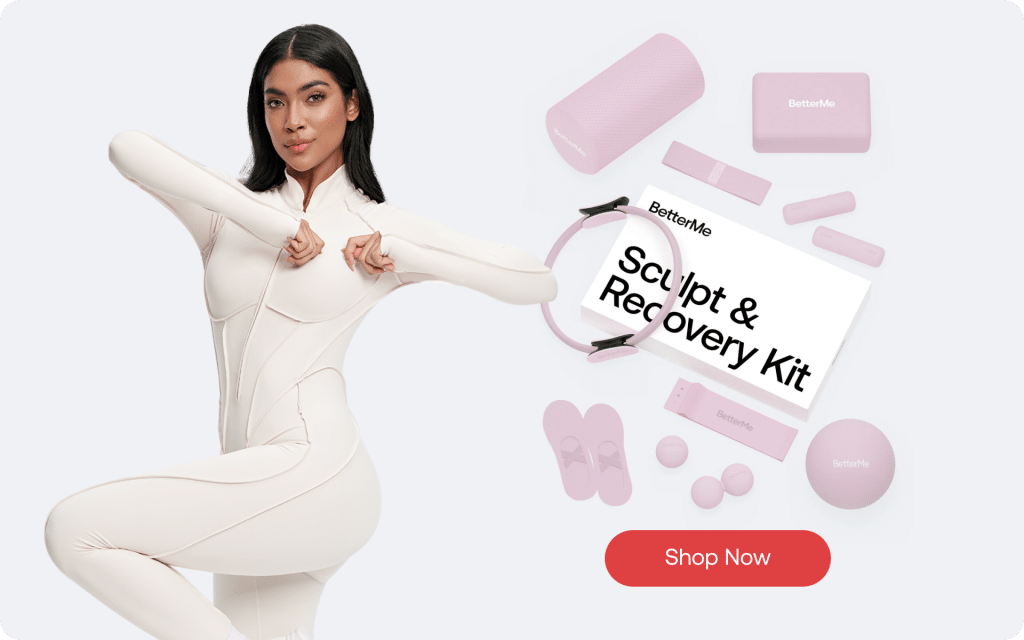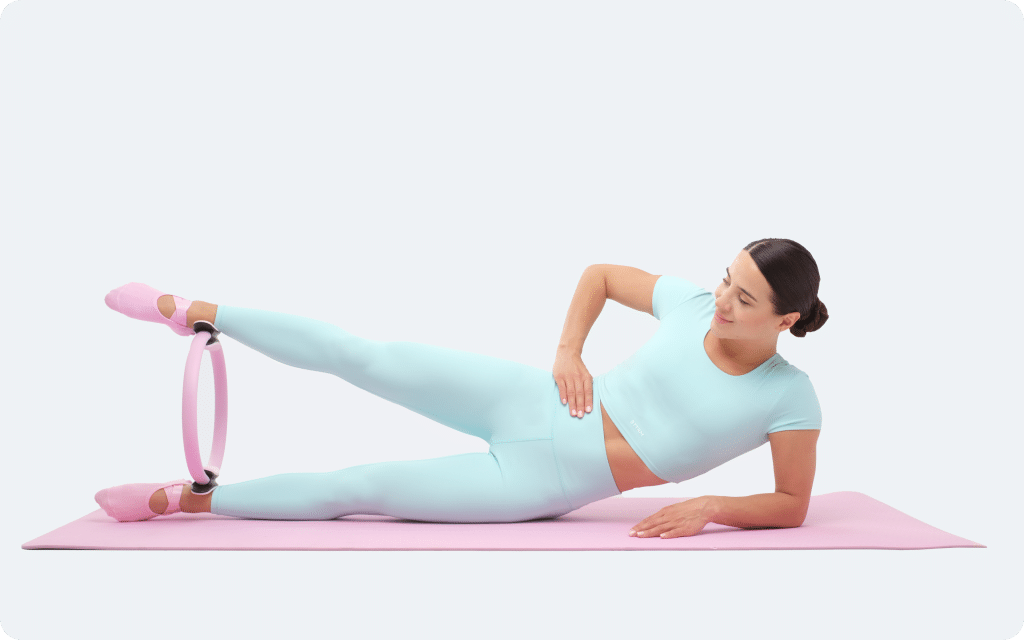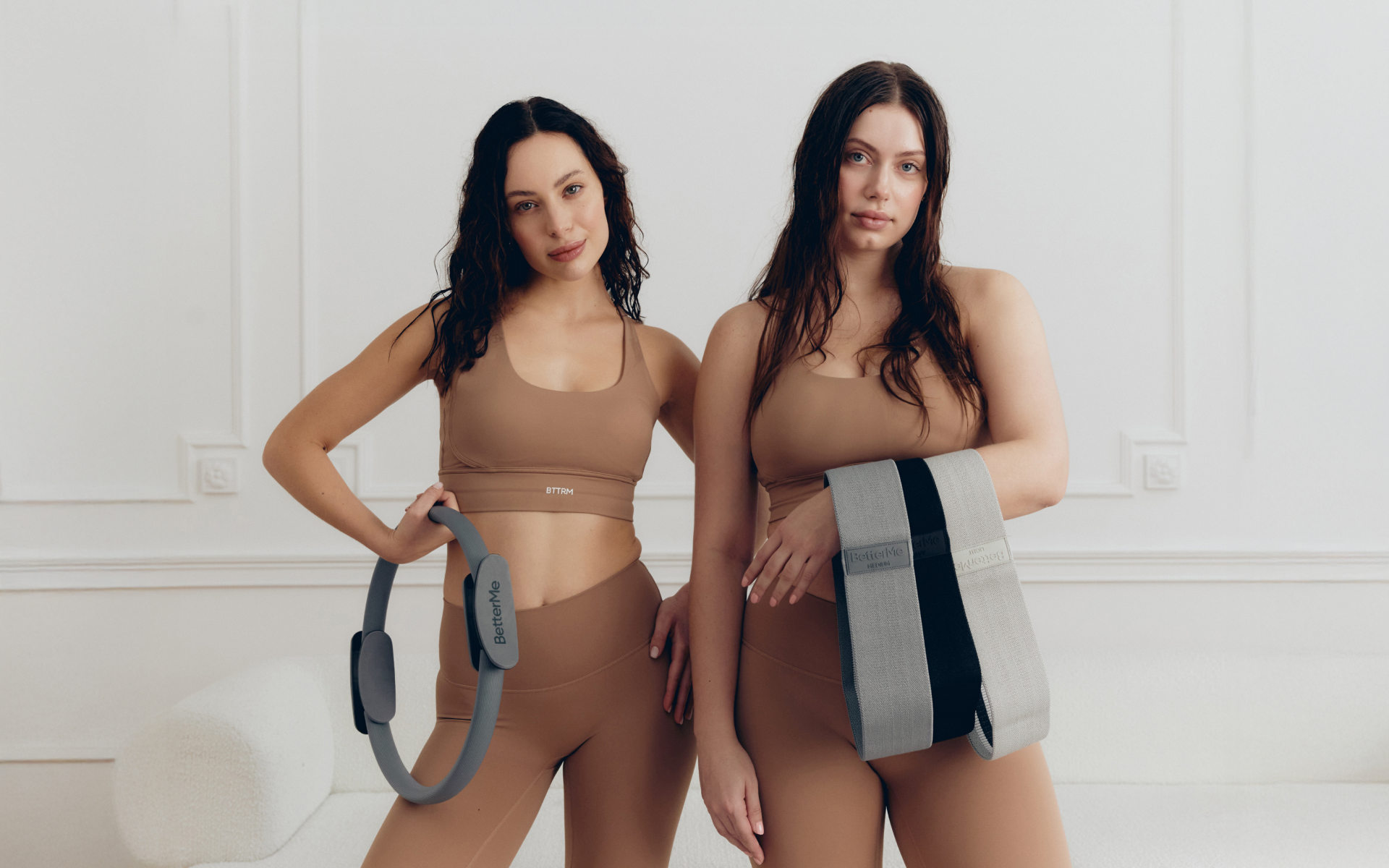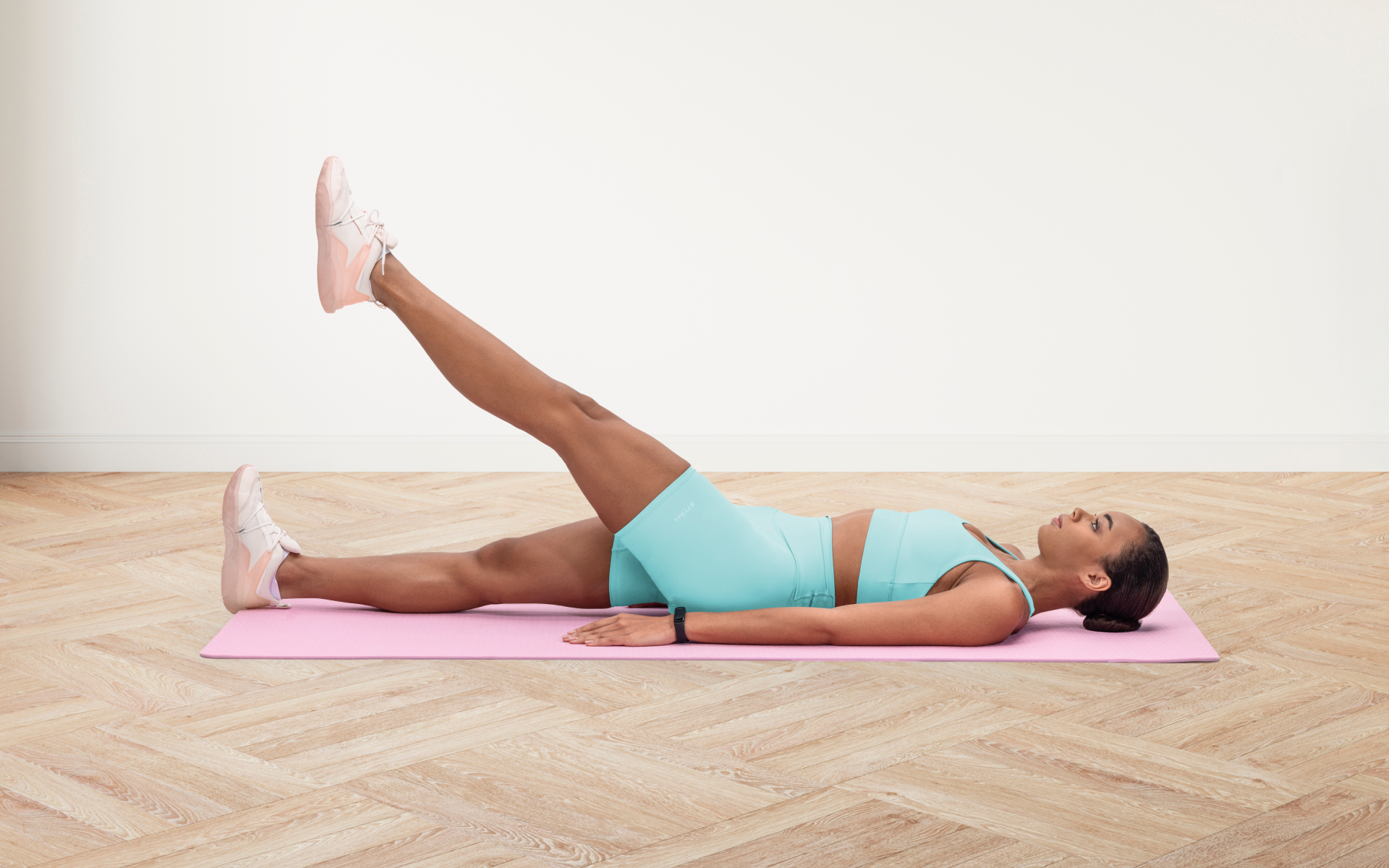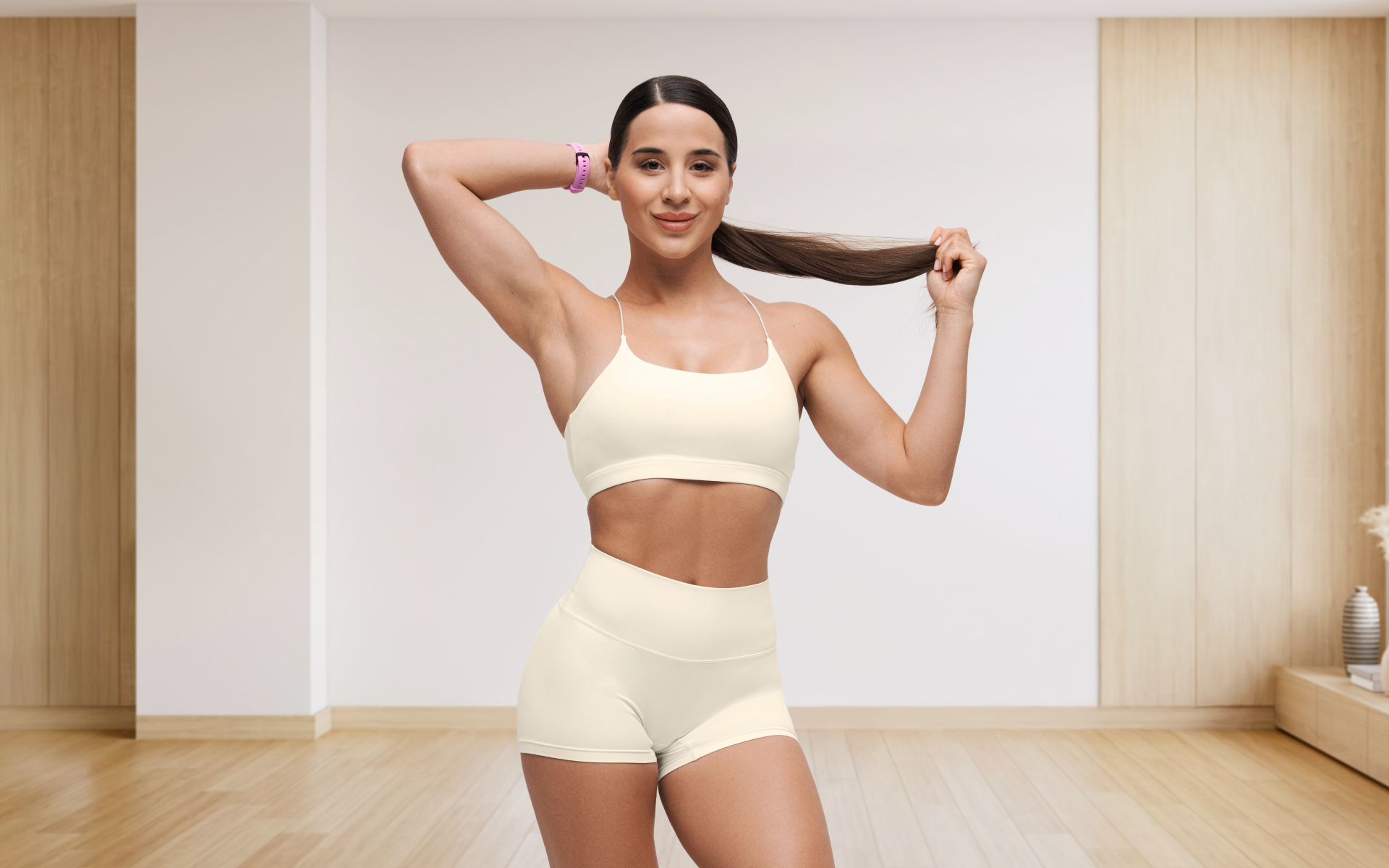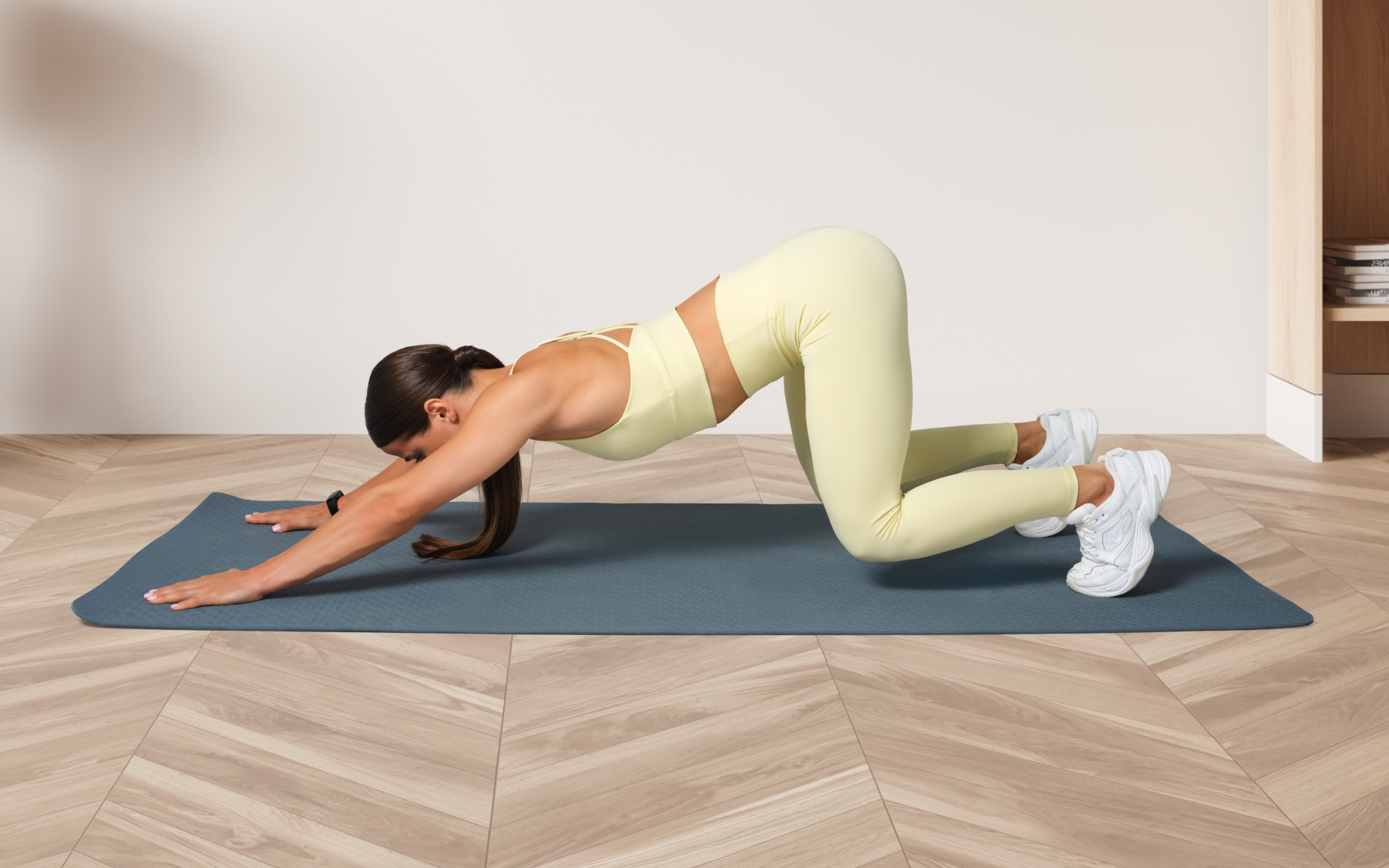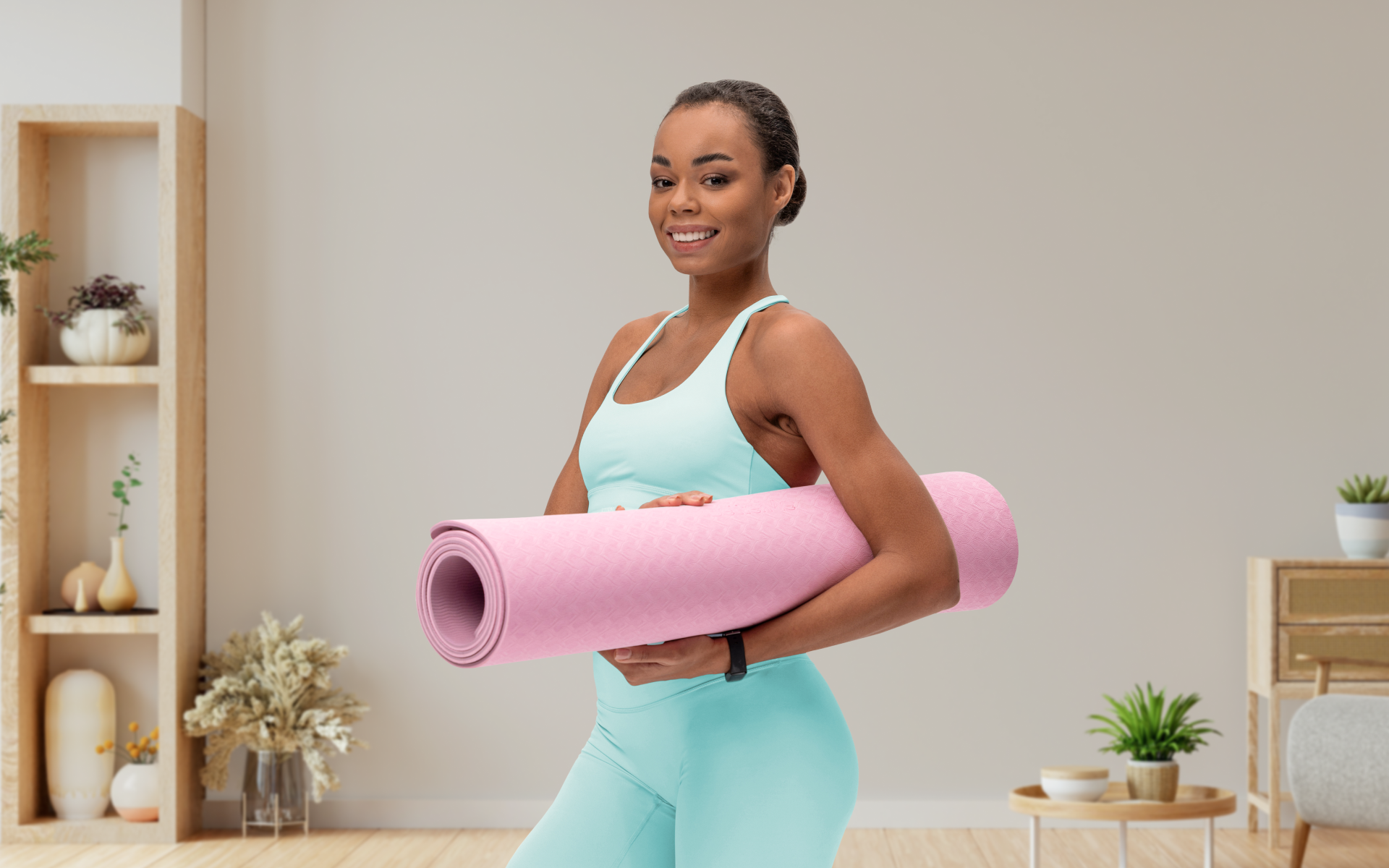It’s a common misconception that you can “tone” muscles. Muscles by nature are lean mass – they can only grow or shrink in size.
If you have a layer of fat covering those muscles, then they won’t be as visible – giving the appearance of being “untoned”.
What people often refer to as “toning” is actually a combination of building muscle and reducing body fat to give the appearance of more defined muscles.
Strength training exercises help build muscle mass, while reducing overall body fat through a combination of a healthy diet and cardio exercises, can make muscles appear more toned.
So, rather than toning muscles directly, it’s about a holistic approach to building muscle and reducing body fat for a leaner appearance.
Now that we’ve gotten that out of the way, let’s talk about Pilates and how it fits into this equation.
Will Pilates “tone” your muscles? Yes, but not in the way you might think.
Can You Get Toned Just By Doing Pilates?
Pilates can be a valuable component of a well-rounded fitness routine aimed at improving muscle tone, but it may be more effective when combined with other forms of exercise and a healthy lifestyle.
Achieving a toned appearance typically requires a combination of factors, including regular exercise that targets various muscle groups, a balanced diet to support muscle definition, and possibly incorporating cardiovascular activities for overall fat loss.
Let’s review each of these components and how Pilates can play a role in achieving toned muscles.
Targeting Various Muscles Groups with Pilates
One of the great things about Pilates is that it can target a variety of muscle groups, all while using your own body weight as resistance.
Pilates exercises often engage multiple muscle groups at once, making for an efficient and effective workout (1).
For example, a classic Pilates exercise such as the Hundred requires coordination and engagement from your core, arms, legs, and back muscles – all in one movement.
By targeting various muscle groups through different Pilates exercises, you can help build lean muscle mass throughout your body for a more toned appearance.
Supporting Muscle Definition with a Healthy, Calorie-Controlled Diet
To achieve toned muscles, you need to have a healthy balance of muscle mass and body fat.
Pilates can help build lean muscle mass, but if it’s covered by excess body fat, those defined muscles won’t be as visible.
This is where a healthy diet comes into play. By consuming the right amount of calories and nutrients, you can support your body in reducing overall body fat and revealing the toned muscles that Pilates helps to build (2).
Aim for a well-rounded diet that includes lean proteins, complex carbohydrates, and plenty of fruits and vegetables (3).
Pilates can support your quest to eat healthy, as it has a mindfulness component that can help you make more conscious choices about the food you eat.
BetterMe app will kick you out of the mental funk, shake off your extra weight, rid you off your energy-zapping habits, and help you sculpt the body of your dreams. Intrigued? Hurry up and change your life for the better!
Incorporating Cardiovascular Exercise for Overall Fat Loss
Without reducing overall body fat, it’s difficult to achieve a truly toned appearance, even with strong muscles.
That’s where cardiovascular exercise comes in. Activities like running, cycling, or swimming can help burn calories and reduce body fat (4).
Incorporating cardio exercises into your routine, along with Pilates, can help support your fitness goals for a leaner and toned physique.
In our previous blog, the Pilates Ring Workout we discuss how to take your Pilates to the next level.
Can You Get a Toned Stomach from Pilates?
Pilates can be part of a plan to achieve a toned stomach, but it’s not the only factor. It engages = your abdominal muscles and builds core strength, but it takes more than just exercise to reveal a defined six-pack. In addition to consistent Pilates practice, you also need to maintain a healthy diet and incorporate cardiovascular activities for overall body fat reduction.
Is Pilates Better Than The Gym for Toning?
Comparing Pilates to the gym is like comparing apples to oranges. They both offer benefits, but in different ways.
Pilates can be a great option for building strength and targeting specific muscle groups, while the gym offers a wider variety of equipment and exercises for an all-around workout.
When comparing the Pilates body to the gym body, many factors come into play, including individual goals, skill level, and personal preferences. Some people may find that they enjoy one form of exercise more than the other, making it easier to stick with consistently.
Ultimately, finding what works best for your body and lifestyle is key – whether that’s Pilates or the gym or a combination of both.
Here’s a list of pros and cons for each to help you decide what’s best for you:
Pilates Pros:
- Can be done at home or in a studio with minimal equipment
- Targets specific muscle groups for toning and strengthening
- Low impact, making it suitable for a majority fitness levels
- Emphasizes proper form and posture, which can have long-term benefits beyond just physical appearance
Pilates Cons:
- May not provide enough cardiovascular exercise on its own
- Limited variety of exercises compared to the gym which reduces the ability to progressively overload the exercise. Progressive overload is one of the critical components of gaining muscle mass.
Gym Pros:
- Offers a wide variety of equipment and classes for a well-rounded workout
- Allows for more flexibility in workouts and targeting different muscle groups
- Can provide a sense of community and motivation through group classes
Gym Cons:
- May require a membership or access to equipment, which can be costly
- Can feel intimidating for beginners or those unfamiliar with gym equipment
Read more: Wall Pilates for Butt: A Quick Guide for Beginners
How Often Should I Do Pilates To Get Toned?
In his book “Return to Life Through Contrology”, Joseph Pilates recommended practicing Pilates at least four times a week for optimal results.
However, the best frequency for you will vary from this, depending on your fitness level and goals.
If you’re new to Pilates, aim for 2-3 times a week to start and gradually increase as you become more comfortable with the exercises (5). If you have specific areas of your body that you want to tone, consider targeting those muscles more frequently within your weekly routine. But make sure to not overdo it. Just because you have a “problem” area you want to target, does not mean you should be spending your workouts only focussing on that area.
8 Must-Have Exercises For Your Pilates Body Transformation
You’ve seen those Pilates before and after photos and are wondering which exercises will help you achieve a similar transformation. While there are countless Pilates exercises to choose from, here are eight suggested moves for building lean muscle mass and achieving a toned physique:
- The Hundred
- Roll-Up
- Single Leg Circle
- Plank
- Side Plank
- Swimming
- Double Leg Stretch
- Teaser
The Hundred (Core, Arms, Legs, Back)
- Lie flat on your back with your legs extended and arms resting by your sides.
- Lift your legs to a 45-degree angle and keep them straight.
- Raise your head, neck, and shoulders off the mat, reaching your arms towards your feet.
- Begin pumping your arms up and down with small, controlled movements.
- Inhale for five counts while pumping your arms.
- Exhale for five counts while continuing to pump your arms.
- Repeat the inhale/exhale cycle ten times for a total of 100 arm pumps.
- Ensure your core remains engaged throughout the exercise to protect your lower back.
- Keep your head and shoulders steady, avoiding unnecessary tension in the neck.
- Slowly lower your legs and head back to the mat to finish the exercise.
Roll-Up (Core, Back, Hamstrings)
- Start by lying flat on your back with your legs extended and arms reaching overhead.
- Inhale deeply and lift your arms towards the ceiling, beginning to peel your head and shoulders off the mat.
- Exhale as you continue to roll up, reaching forward towards your toes while keeping your legs straight.
- Pause for a moment when your hands are parallel to your toes, engaging your core.
- Inhale and begin to roll back down, vertebra by vertebra, ensuring your movements are controlled.
- Exhale as you bring your arms back overhead to return to the starting position.
- Repeat the movement, flowing smoothly through each roll-up.
- Ensure your movements are fluid, avoiding jerky or rushed actions.
- Keep your core engaged throughout the exercise to protect your lower back.
- Perform the roll-up slowly and with control to maximize muscle engagement and flexibility.
Single Leg Circle (Core, Hips, Legs)
- Lie flat on your back with your legs extended and arms resting by your sides.
- Raise one leg towards the ceiling, keeping it straight and flexing the foot.
- Engage your core to stabilize your torso and prevent your lower back from arching.
- Inhale as you begin to draw a circle with your raised leg, moving from the hip.
- Make the circle as large as you can while maintaining control of your core and leg muscles.
- Exhale as you complete the circle, returning your leg to the starting position.
- Repeat the circle in the opposite direction, maintaining control and stability.
- Perform 5-10 circles on one leg, then switch to the other leg.
- Ensure your stationary leg remains straight and grounded on the mat.
- Focus on controlled, smooth movements, avoiding any swinging or jerking.
Lean and toned up body isn’t just a far-fetched fantasy. Check out the BetterMe app and watch it propel your weight loss journey into high gear!
Plank (Core, Arms, Shoulders, Back, Legs)
- Start by positioning yourself on all fours, with your hands directly under your shoulders and knees under your hips.
- Step your feet back one at a time to extend your legs and balance on the balls of your feet.
- Keep your body in a straight line from head to heels, avoiding any sagging or arching of the back.
- Engage your core and tighten your abdominal muscles.
- Ensure your shoulders are aligned with your wrists and your neck is neutral.
- Distribute your weight evenly between your hands and feet.
- Hold the plank position and breathe steadily.
- Maintain this position for at least 30 seconds, gradually increasing the duration as you build strength.
- Keep your body straight and avoid letting your hips drop.
- Slowly lower your knees to the mat and rest.
Side Plank (Core, Arms, Shoulders, Hips, Legs)
- Begin by lying on your side with your legs extended and feet stacked one on top of the other.
- Place your bottom elbow directly under your shoulder, with your forearm resting on the mat for support.
- Engage your core and lift your hips off the mat to form a straight line from head to heels.
- Keep your top arm resting along your side or extended towards the ceiling.
- Hold the position and breathe steadily, keeping your core tight and hips lifted.
- Ensure your shoulders and hips remain aligned, avoiding any rotation or sagging.
- Maintain this side plank position for 15-30 seconds, increasing the duration over time.
- Slowly lower your hips back to the mat and switch to the other side.
- Repeat the exercise on the opposite side, maintaining proper form and control.
- Perform 2-3 sets on each side for a complete core workout.
Swimming (Core, Back, Shoulders, Glutes, Legs)
- Lie face down on the mat with your arms extended straight overhead and legs extended behind you.
- Engage your core and lift your head, chest, arms, and legs off the mat.
- Keep your neck in a neutral position, avoiding any tension.
- Begin alternating lifting your right arm and left leg, then your left arm and right leg in a swimming motion.
- Inhale as you lift one arm and opposite leg.
- Exhale as you switch sides, lifting the other arm and opposite leg.
- Maintain a steady and controlled rhythm, avoiding any jerky movements.
- Keep your core engaged and your back muscles active throughout the exercise.
- Continue alternating for 10-20 repetitions, depending on your fitness level.
- Lower your arms and legs back to the mat and rest briefly before repeating for another set.
Read more: Pilates Full Body Workout for Beginners (No Equipment Needed)
Double Leg Stretch (Core, Back, Legs, Arms)
- Begin by lying flat on your back with your knees bent and pulled into your chest.
- Hold onto your shins with both hands, keeping your head, neck, and shoulders off the mat.
- Inhale deeply as you extend your arms overhead and your legs out straight at a 45-degree angle.
- Ensure your lower back remains pressed into the mat to protect your spine.
- Exhale and circle your arms around to grasp your shins again, drawing your knees back into your chest.
- Keep your core engaged throughout the movement to maintain stability.
- Repeat the extension and circling motion in a smooth, controlled manner.
- Perform the stretch 8-10 times, focusing on synchronized breathing and fluidity.
- Keep your movements steady to avoid straining your neck or lower back.
- Rest briefly and repeat for another set if desired.
Teaser (Core, Back, Hips, Legs)
- Start by sitting on the mat with your knees bent and feet flat on the floor.
- Extend your arms straight out in front of you at shoulder height.
- Slowly roll down onto your back, keeping your knees bent with your feet on the mat.
- Inhale deeply, then exhale as you lift your head, shoulders, and upper back off the mat.
- Simultaneously extend your legs to a 45-degree angle, reaching your arms towards your toes.
- Hold the teaser position momentarily, engaging your core for stability.
- Inhale as you roll down, gently lowering your legs back to the mat while maintaining control.
- Exhale as you lift back into the teaser position, flowing smoothly through each repetition.
- Avoid using momentum and focus on controlled movements.
- Repeat the teaser 5-8 times, ensuring proper form and engagement of the core muscles throughout.
Read on and discover wall pilates arm exercises in our, Wall Pilates Arms article.
FAQs
How Quickly Will Pilates Change My Body?
Pilates may provide noticeable changes in your body within a few weeks or months of consistent practice. However, the speed of change will vary, depending on factors such as your current fitness level, frequency and intensity of Pilates sessions, daily caloric intake and overall lifestyle habits. Consistency is key to seeing results from any exercise program.
Is Pilates Enough To Stay Fit?
Pilates enhances some areas of fitness, including core strength, flexibility, balance, and posture. However, it may not be enough to solely rely on Pilates for overall fitness. It is recommended to incorporate other forms of exercise such as cardio and strength training for a well-rounded fitness routine (6).
We’ve compared pilates and calisthenics, explained their benefits and how to incorporate both into your routine in our Pilates vs Calisthenics blog.
Will Pilates Change My Body Shape?
Pilates can help improve your posture, which may indirectly change the appearance of your body. It also helps build lean muscle and burn fat, leading to a more toned physique. However, Pilates does not promise drastic weight loss or major physical changes. Results will vary depending on individual factors such as genetics
What Is The Best Exercise for Toning?
Any exercise that engages and challenges your muscles can contribute to toning. Strength training exercises, including Pilates, can be beneficial for building lean muscle mass and toning the body. However, a combination of various forms of exercise and a healthy diet is essential for achieving a toned body.
The Bottom Line
So, is Pilates good for toning? Absolutely! But remember that achieving a toned appearance requires a combination of factors, including regular exercise, a healthy diet, genetics, and possibly incorporating cardiovascular activities.
Pilates can be a valuable tool in this journey towards toned muscles, as it helps build muscle mass and can improve overall body strength. Exercises that target multiple muscle groups, mindfulness in food choices, and a well-rounded fitness routine can all work together to give you the toned physique you desire.
DISCLAIMER:
This article is intended for general informational purposes only and does not serve to address individual circumstances. It is not a substitute for professional advice or help and should not be relied on for making any kind of decision-making. Any action taken as a direct or indirect result of the information in this article is entirely at your own risk and is your sole responsibility.
BetterMe, its content staff, and its medical advisors accept no responsibility for inaccuracies, errors, misstatements, inconsistencies, or omissions and specifically disclaim any liability, loss or risk, personal, professional or otherwise, which may be incurred as a consequence, directly or indirectly, of the use and/or application of any content.
You should always seek the advice of your physician or other qualified health provider with any questions you may have regarding a medical condition or your specific situation. Never disregard professional medical advice or delay seeking it because of BetterMe content. If you suspect or think you may have a medical emergency, call your doctor.
SOURCES:
- Effects of a Pilates exercise program on muscle strength, postural control and body composition: results from a pilot study in a group of post-menopausal women (2015,nih.gov)
- Calorie Deficit: What To Know (2022,clevelandclinic.org)
- Optimal Diet Strategies for Weight Loss and Weight Loss Maintenance (2021,nih.gov)
- Aerobic exercise alone results in clinically significant weight loss for men and women: Midwest Exercise Trial-2 (2013,nih.gov)
- Integrating Pilates exercise into an exercise program for 65+ year-old women to reduce falls (2011,jssm.org)
- Cross Training (n,d,orthoinfo.aaos.org)

